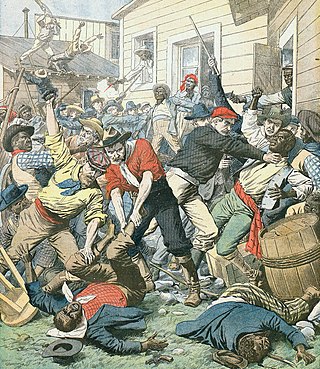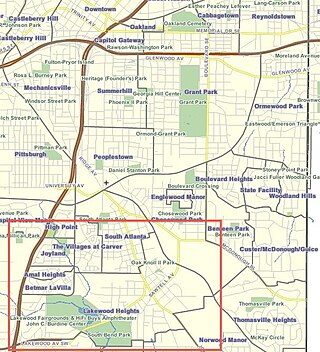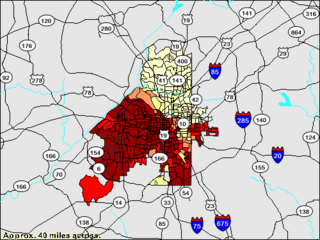
Ray Stannard Baker was an American journalist, historian, biographer, and author.

The history of Atlanta dates back to 1836, when Georgia decided to build a railroad to the U.S. Midwest and a location was chosen to be the line's terminus. The stake marking the founding of "Terminus" was driven into the ground in 1837. In 1839, homes and a store were built there and the settlement grew. Between 1845 and 1854, rail lines arrived from four different directions, and the rapidly growing town quickly became the rail hub for the entire Southern United States. During the American Civil War, Atlanta, as a distribution hub, became the target of a major Union campaign, and in 1864, Union William Sherman's troops set on fire and destroyed the city's assets and buildings, save churches and hospitals. After the war, the population grew rapidly, as did manufacturing, while the city retained its role as a rail hub. Coca-Cola was launched here in 1886 and grew into an Atlanta-based world empire. Electric streetcars arrived in 1889, and the city added new "streetcar suburbs".
An African American is a citizen or resident of the United States who has origins in any of the black populations of Africa. African American-related topics include:

Clark Atlanta University is a private, Methodist, historically black research university in Atlanta, Georgia. Clark Atlanta is the first Historically Black College or University (HBCU) in the Southern United States. Founded on September 19, 1865, as Atlanta University, it consolidated with Clark College to form Clark Atlanta University in 1988. It is classified among "R2: Doctoral Universities – High research activity".

The Sweet Auburn Historic District is a historic African-American neighborhood along and surrounding Auburn Avenue, east of downtown Atlanta, Georgia, United States. The name Sweet Auburn was coined by John Wesley Dobbs, referring to the "richest Negro street in the world," one of the largest concentrations of African-American businesses in the United States.

The Wilmington insurrection of 1898, also known as the Wilmington massacre of 1898 or the Wilmington coup of 1898, was a coup d'état and massacre carried out by white supremacists in Wilmington, North Carolina, United States, on Thursday, November 10, 1898. The white press in Wilmington originally described the event as a race riot caused by black people. Since the late 20th century and further study, the event has been characterized as a violent overthrow of a duly elected government by a group of white supremacists. It is considered by historians to be a unique episode in the history of the United States.

The Interdenominational Theological Center (ITC) is a consortium of five predominantly African-American denominational Christian seminaries in Atlanta, Georgia, operating together as a professional graduate school of theology. It is the largest free-standing African-American theological school in the United States.

Violent reprisals by armed mobs of White Americans against African Americans in Atlanta, Georgia, began after newspapers, on the evening of September 22, 1906, published several unsubstantiated and luridly detailed reports of the alleged rapes of 4 local women by black men. The violence lasted through September 24, 1906. The events were reported by newspapers around the world, including the French Le Petit Journal which described the "lynchings in the USA" and the "massacre of Negroes in Atlanta," the Scottish Aberdeen Press & Journal under the headline "Race Riots in Georgia," and the London Evening Standard under the headlines "Anti-Negro Riots" and "Outrages in Georgia." The final death toll of the conflict is unknown and disputed, but officially at least 25 African Americans and two whites died. Unofficial reports ranged from 10–100 black Americans killed during the massacre. According to the Atlanta History Center, some black Americans were hanged from lampposts; others were shot, beaten or stabbed to death. They were pulled from street cars and attacked on the street; white mobs invaded black neighborhoods, destroying homes and businesses.

John Wesley Edward Bowen was born into American slavery and became a Methodist clergyman, denominational official, college and university educator and one of the first African Americans to earn a Ph.D. degree in the United States. He is credited as the first African American to receive the Ph.D. degree from Boston University, which was granted in 1887.

Ariel Serena Hedges Bowen was an African-American writer, temperance activist, and professor of music at Clark University in Atlanta in the late 19th and early 20th centuries. Twentieth Century Negro Literature (1902) noted that "she is regarded as one of the foremost and best cultured women of her race." She was a life member of the Woman's Foreign Missionary Society of the Methodist Episcopal Church.

Adair Park is a residential neighborhood located southwest of downtown Atlanta. It has the form of a left curly bracket, bordered by the MARTA north–south rail line on the northwest, the BeltLine trail on the southwest and Metropolitan Parkway on the east. Historically Adair Park also included the area from Metropolitan Parkway to McDaniel Street on the east, but the city now considers that area part of the Pittsburgh neighborhood.
Summerhill is a neighborhood directly south of Downtown Atlanta between the Atlanta Zoo and Center Parc Stadium. It is bordered by the neighborhoods of Grant Park, Mechanicsville, and Peoplestown. Established in 1865, Summerhill is one of Atlanta’s oldest neighborhoods and part of the 26 neighborhoods making up the Atlanta Neighborhood Planning Unit system.

Lakewood Heights is a primarily Black neighborhood in southeast Atlanta. It is bounded by:

Jackson Row was an African-American slum in Atlanta. Author Ray Stannard Baker described the area in 1907 in language that is offensive to current sensibilities, but nonetheless provides one of the few existing descriptions of the area:
One of a number of black settlements in Atlanta. Small, dilapidated houses crowded into irregular alleys are filled with negroes, many of them widows with children, who make a living by serving white families. These negroes are all near the edge of poverty, descending sometimes into crime, but living a happy-go-lucky life.

Black Atlantans are residents of the city Atlanta who are of African American ancestry. Atlanta has long been known as a center of black wealth, higher education, political power and culture; a cradle of the Civil Rights Movement.
The following is a timeline of the history of the city of Atlanta, Georgia, United States.

William H. Crogman was a pioneering African American educator and classicist at Clark University of Atlanta in the United States. The William H Crogman School in Atlanta is named for him.
Dixie Hills is a historic neighborhood of northwest Atlanta with a population of 1,756 (2010).
Ben Hill United Methodist Church is a United Methodist Church in the predominantly Black neighborhood of Ben Hill, Atlanta, in the US state of Georgia. It started in 1853 in a log cabin and was called "Wesley Chapel". The congregation moved to Ben Hill in 1926, and when in the 1960s that neighborhood become mostly Black, the church chose to accept that and integrate. By 1974 the church had become predominantly Black, with Cornelius Henderson as its first Black pastor, and the church grew--from 400 members in 1974 to 4,000 in 1986. Under his successor, Walter Kimbrough Sr., that membership increased to 6,000 by 1989, making Ben Hill UMC "reportedly the largest African American congregation of the United Methodist Church". Its "spiritual awakening and phenomenal numerical growth" are ascribed to its incorporation of "African traditions of call and response" and a neo-Pentecostal style.














